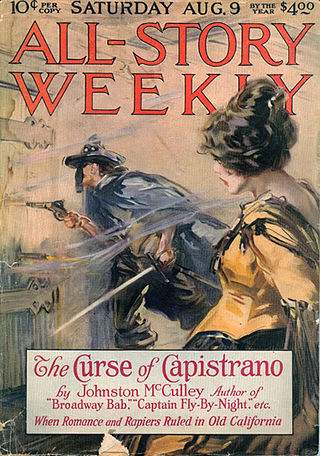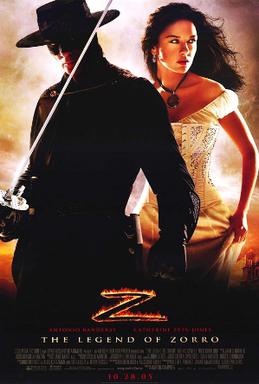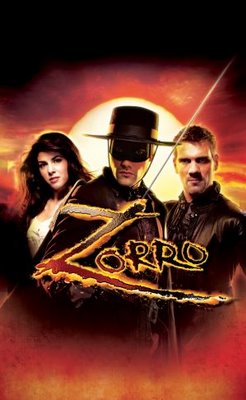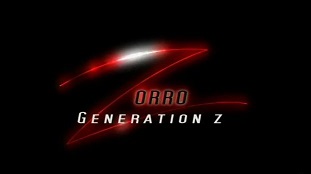
Zorro is a fictional character created in 1919 by American pulp writer Johnston McCulley, appearing in works set in the Pueblo of Los Angeles in Alta California. He is typically portrayed as a dashing masked vigilante who defends the commoners and Indigenous peoples of California against corrupt, tyrannical officials and other villains. His signature all-black costume includes a cape, a hat known as a sombrero cordobés, and a mask covering the upper half of his face.

The Mask of Zorro is a 1998 American Western swashbuckler film based on the fictional character Zorro by Johnston McCulley. It was directed by Martin Campbell and stars Antonio Banderas, Anthony Hopkins, Catherine Zeta-Jones, and Stuart Wilson. The film features the original Zorro, Don Diego de la Vega (Hopkins), escaping from prison to find his long-lost daughter (Zeta-Jones) and avenge the death of his wife at the hands of the corrupt governor Rafael Montero (Wilson). He is aided by his successor (Banderas), who is pursuing his own vendetta against the governor's right-hand man while falling in love with de la Vega's daughter.
A tornado is a violent rotating column of air that touches the surface of the Earth.

The Mark of Zorro is a 1940 American black-and-white swashbuckling film released by 20th Century-Fox, directed by Rouben Mamoulian, produced by Darryl F. Zanuck, and starring Tyrone Power, Linda Darnell, and Basil Rathbone.

The Mark of Zorro is a 1920 American silent Western romance film starring Douglas Fairbanks and Noah Beery. This genre-defining swashbuckler adventure was the first movie version of The Mark of Zorro. Based on the 1919 story The Curse of Capistrano by Johnston McCulley, which introduced the masked hero, Zorro, the screenplay was adapted by Fairbanks and Eugene Miller.

The Legend of Zorro is a 2005 American Western swashbuckler film directed by Martin Campbell, produced by Walter F. Parkes, Laurie MacDonald and Lloyd Phillips, with music by James Horner, and written by Roberto Orci and Alex Kurtzman. It is the sequel to 1998's The Mask of Zorro; Antonio Banderas and Catherine Zeta-Jones reprise their roles as the titular hero and his spouse, Elena, and Rufus Sewell stars as the villain, Count Armand. The film takes place in San Mateo County, California and was shot in San Luis Potosí, Mexico, with second-unit photography in Wellington, New Zealand. The film was theatrically released on October 28, 2005, by Columbia Pictures, and earned $142.4 million on a $65 million budget.

Zorro is an American action-adventure Spanish Western television series produced by Walt Disney Productions and starring Guy Williams. Based on the Zorro character created by Johnston McCulley in his 1919 novella, the series premiered on October 10, 1957, on ABC. The final network broadcast was July 2, 1959. Seventy-eight episodes were produced, and four hour-long specials were aired on the Walt Disney anthology series between October 30, 1960, and April 2, 1961.

Zorro is a 2005 novel by Chilean author Isabel Allende. Its subject is the American pulp hero Diego de la Vega, better known as El Zorro. He first appeared as a character in Johnston McCulley's novella The Curse of Capistrano (1919). His character and adventures have also been adapted for an American TV series, other books, and cartoon series.

The Mark of Zorro is a 1974 American Western television film which stars Frank Langella alongside Gilbert Roland, Yvonne De Carlo, Anne Archer, Ricardo Montalbán and Robert Middleton.

Zorro's Fighting Legion is a 1939 Republic Pictures film serial consisting of twelve chapters starring Reed Hadley as Zorro and directed by William Witney and John English. The plot revolves around his alter-ego Don Diego's fight against the evil Don Del Oro.

The Legend of Zorro is a Japanese anime, based on the western character Zorro. The series was initially broadcast in Italy in 1994 before being broadcast in Japan two years later, albeit with some episodes skipped.

El Zorro, la espada y la rosa is a Spanish-language telenovela based on Johnston McCulley's characters. Telemundo aired it from February 12 to July 23, 2007. This limited-run serial shows the masked crusader as a hero torn between his fight for justice and his love for a beautiful woman. Telemundo president Don Browne called this show "without doubt the best production offered on Hispanic television in the United States today."

The New Adventures of Zorro is an American animated television series produced by Filmation in 1981. The series, which has 13 episodes, is based on the fictional character created by Johnston McCulley. It aired as part of The Tarzan/Lone Ranger/Zorro Adventure Hour.

Zorro is a musical with music by the Gipsy Kings and John Cameron, a book by Stephen Clark and Helen Edmundson, and lyrics by Stephen Clark. It is inspired by the 2005 fictional biography Zorro, the first original story of the pulp hero Zorro, written by Chilean author Isabel Allende. It also contains numerous references to earlier Zorro-related works, especially the 1998 film The Mask of Zorro. The original musical did a trial run tour which proved to be successful, and led to a transfer to the West End.

Zorro is an American Western superhero television series featuring Duncan Regehr as the character of Zorro. Regehr portrayed the fearless Spanish hero and fencer on The Family Channel from 1990 to 1993. The series was shot entirely in Madrid, Spain and produced by New World Television (U.S.), The Family Channel (U.S.), Ellipse Programme of Canal Plus (France), Beta TV (Germany), and RAI (Italy). 88 episodes of the series were produced, Raymond Austin directed 55 episodes and produced 37. There were 10 more episodes made than the first Zorro television series, which was produced by Disney in the late 1950s.

Zorro: Generation Z is an animated series that began in 2006, and produced by BKN International, BKN New Media and Zorro Productions. Former Marvel Studios development executive Rick Ungar developed the original series. The programming deal and concept for the new series was developed by Ungar, G7, and Pangea and underwritten partially by a master toy license with Brazilian toy company, Gulliver Toys. What made the show unique were the plethora of Pangea-designed high tech gadgets and the conceit of having the young Zorro ride his motorcycle named after his horse, Tornado.

The Bold Caballero is a 1936 American Western film written and directed by Wells Root. It is based on the character Zorro, created by Johnston McCulley. The characters Don Alejandro Vega and Bernardo are notably absent. Native American stars include Chief Thundercloud as Don Diego Vega/Zorro's aide and Charles Stevens as Captain Vargas. John Merton appears uncredited in this film as a First Sergeant. Merton also appears in Zorro's Fighting Legion as Manuel and Zorro's Black Whip as Harris. The film is notable for being the first talking Zorro film, as the first two Zorro films were silent films, and the first Zorro film in color (Magnacolor). It was shot in Chatsworth, Los Angeles. The film was released on December 1, 1936, by Republic Pictures.
The Great Adventure of Zorro is a 1976 film starring Rodolfo de Anda in a Mexican version of Zorro, directed by Raúl de Anda and featuring such actors as Helena Rojo and Pedro Armendáriz, Jr.

Toronado is an Irish-bred, British-trained Thoroughbred racehorse. He was one of the leading British two-year-olds of 2012 when he was undefeated in three races including the Champagne Stakes at Doncaster. After winning the Craven Stakes on his three-year-old debut he came to be regarded as a leading contender for the 2000 Guineas and Epsom Derby. In the summer of 2013 he developed a rivalry with Dawn Approach and defeated the Irish colt to record his most important win in the Sussex Stakes. In 2014 he won the Queen Anne Stakes but was beaten by Kingman in the Sussex Stakes and by Charm Spirit in the Prix du Moulin and finished unplaced when favourite for the Breeders' Cup Mile.















